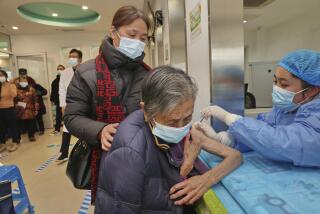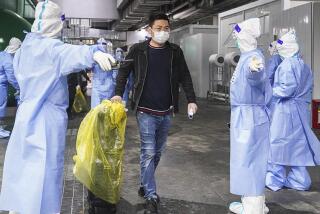Bush Authorizes Quarantine of SARS Victims
- Share via
While the mysterious illness known as SARS continued to spread around the world, President Bush signed an executive order Friday allowing U.S. officials to quarantine victims of SARS and other infectious diseases.
U.S. researchers also have begun working on a possible vaccine for the disease, and World Health Organization representatives have begun investigating the original outbreak in China’s Guangdong province in hopes of learning how the outbreak started.
As of Friday, there were 2,353 severe acute respiratory syndrome cases worldwide and 84 deaths, an increase of 83 cases and five deaths compared with Thursday, according to the WHO. But the new data included the first information from China’s new online electronic system, which reported 30 new cases and three deaths over a three-day period.
Outside China, there has been an average of about 50 new cases a day for most of this week, hinting that the outbreak may be leveling off.
The federal Centers for Disease Control and Prevention said the number of suspected U.S. cases climbed to 115 Friday, with all the new cases among people who have traveled to Asia. Of the 115 cases, only four are among family members of victims and two among health-care workers -- numbers that have not changed since the beginning of the outbreak. CDC officials are cheered by that news because it suggests there has been no community transmission of the infectious agent.
At the urging of Health and Human Services Secretary Tommy G. Thompson, Bush signed an order Friday that calls for the “apprehension, detention or conditional release of individuals to prevent the introduction, transmission or spread of suspected communicable diseases.” Health officials already had authority to quarantine people suspected of exposure to smallpox, diphtheria, tuberculosis and other diseases. The new order represented the first addition to the list in two decades.
HHS officials stressed that they had no plans to implement quarantines, but that the order gave the ability to do so if circumstances dictated a need.
The order gives Thompson authority to determine when a quarantine would be appropriate. Officials reportedly decided to seek the order after a woman suffering symptoms of SARS arrived on a flight from Asia and refused to go to a hospital. Officials at the airport realized they had no authority to detain her.
CDC Director Dr. Julie L. Gerberding has said repeatedly during the outbreak that officials rarely invoke the authority and are unlikely to do so in this case. A quarantine would affect people who have been exposed to the disease but have not yet developed symptoms. Those with symptoms are generally put into isolation, a common procedure with infectious diseases.
Separately, U.S. Surgeon General Richard H. Carmona said he supports pre-screening passengers for the virus before they board airplanes for international flights.
China, where the disease is believed to have originated early this year, has been heavily criticized for withholding information about the outbreak and for preventing WHO officials from visiting Guangdong province, where the first cases occurred.
“Today, we apologize to everyone,” said Li Liming, director of the Chinese Center for Disease Control. “Our medical departments and our [government-controlled] mass media suffered poor coordination.”
A WHO team headed by the CDC’s Dr. Robert Breiman arrived in Guangdong Thursday and is now reviewing data about the outbreak. Authorities are particularly interested in a man in the city of Foshan who may be one of the earliest victims and who is suspected of spreading it to four other people -- but not to his children. Chinese officials have not released any information about the man, but persistent press reports suggest that he either cooked or ate wild game.
Chinese researchers said Friday that they were “80% sure” that SARS is caused by a bacterium similar to Chlamydia pneumoniae. That bacterium, which is distinct from the sexually transmitted strain, is a common cause of pneumonia, especially in the developing world.
But researchers elsewhere are less certain. Most are convinced that the disease is caused by a previously unrecognized coronavirus. Coronaviruses are a family of viruses that cause about 10% to 25% of common colds, as well as other respiratory infections.
Dr. James Hughes of the CDC said Friday that 10 of the 12 labs now studying the disease have identified coronaviruses in tissue samples. Those labs “have all looked for evidence of chlamydia infection and have not found it,” he said.
Researchers are so confident of coronavirus’ role that researchers at the National Institutes of Health have already begun working on the development of a possible vaccine against it. Dr. Brian Murphy of the NIH’s National Institute of Allergy and Infectious Disease said researchers there will try to produce a killed-virus vaccine, one of the simplest types of vaccines.
He said the team is now trying to grow adequate quantities of the virus in the laboratory, after which it will be necessary to concentrate the virus, kill it to prevent infection and test it in animals. He said it would be at least a year before a vaccine could be available.
Hong Kong, which has seen the most incidents of SARS outside mainland China, reported 27 new cases Friday, bringing the total there to 761 cases. The new victims include five health-care workers and eight residents of the Amoy Garden apartment complex, site of a mysterious concentration of more than 200 cases of the disease.
More to Read
Sign up for Essential California
The most important California stories and recommendations in your inbox every morning.
You may occasionally receive promotional content from the Los Angeles Times.













